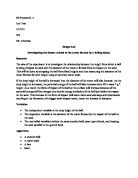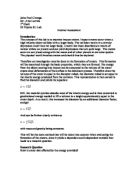DCP
The measurements were made and the results were written down.
Uncertainties noted in Table1. are considered as the uncertainties of equipment; both measuring tape and side clipper has the smallest unit 1mm- in this experiment the universal uncertainty of equipment is established to be half of the smallest unit. Therefore the uncertainty is equal to 0.05 cm.
Having done more measurements than needed, two of them could be omitted. I chose two extreme values (minimal and maximal) to be not included in further calculations. Later on I calculated the average values for the craters using the equation:
The uncertainty of the average value of measurement was calculated using equation:
Graph1: Best fit lines for big and small ball.
Graph2: The relationship between height of the ball and the depth of crater. Ball first.
Graph3: The relationship between height of the ball and the depth of crater. Ball second.
CE
I calculated the gradient for both balls.
First ball:
y=0.0115x + 1.1
x=60
y=1.79
gradient= =0.029
Later on I calculated the uncertainty. I used data on the graph (the steepest and least steep):
uncertainty===0.00335
I made the same calculations with second ball:
Second ball:
y=0.01155x + 0.904
x=60
y=1.597
gradient==0.026
Later on I calculated the uncertainty. I used data on the graph (the steepest and least steep):
uncertainty===0.00264
The graphs (representing the relationship between the height from which the ball was let freely and the depth of the crater formed by this ball) concerning both balls are similar.
In both cases the depth of the crater increases with the height from which the ball fell. This means the higher the position of the ball, the deeper crater formed. At the height of 40 cm the craters formed are the shallowest, then at 60 cm are deeper, but shallower than at 80 cm and 100 cm. At 100 cm the craters formed by the ball are the deepest.
The depth of the craters for bigger ball fits in the range 1.37 to 2.10 cm (where the 1.37 is the smallest height of 40 cm and the 2.10 cm is the highest 100 cm). The range of crater depths for small balls are 1.52 to 2.23 cm (again, with 1.52 cm being at the smallest height of 40 cm and 2.23 cm being the highest 100 cm).
The higher the ball is in the initial position, the deeper crater is formed (Table2.). It is because the higher the ball is, the longer time it has to fall and therefore the higer velocity can be reached while the potential energy is converted to kinetic energy.
Comparing the depth of craters formed by both balls, I noticed that the smaller ball makes deeper crater than the bigger one, for example from the height of 60 cm the crater formed by big ball is 1.63 cm while the depth of small ball is 1.85 cm. I assumed that the ball with bigger mass makes deeper craters but the bigger ball has bigger mass and makes shallower craters.
I decided to calculated the density of both balls.
Knowing that:
- First ball has mass 97.14 g and the diameter is 4.2 cm
- Second ball has mass 79.04 g and the diameter is 2.8 cm
I calculated the volume of each ball:
V= where П=3.14 and r-radius
r=2.1 cm V1=38.77 cm3
r=1.4 cm V2=11.49 cm3
Having both mass and the volume of the balls, I calculated the density:
d=
d1= =2.505 d2==6.879
As can be seen, the smaller ball with higher density but smaller mass makes deeper craters than the bigger ball with bigger mass but smaller density.
Possible error that occur in the experiment and further improvements are:
-
Loss of sand during taking the measurements- after the ball hit the surface of the sand to make a crater, some amount of sand has been lost which later influenced the depth of crater formed. To avoid this, I suggest to establish sand level by marking the tank and to supplement the missing sand.
-
Uncertainty of equipment- in this experiment only used were: measuring tape, side clipper and the balance. The uncertainties were small ( tape and clipper ±0.05 cm and the balance ±0.01 g) and therefore their influence on the obtained results was insignificant. To reduce the uncertainty I suggest to use the same equipment during the whole experiment; therefore there would be no disparity between the measuring scales.
-
Initial velocity different than o ms-1 – when the ball was let from a given height it might have happened that the additional velocity was used. The ball was let using hand which might delicately push it. As can be seen in Table2. the values were similarly spaced so I assumed it also didn't have a big influence on the results.
-
Additional forces acting on the ball like air friction- the air friction acting onthe falling ball affected the velocity reach by this ball and therefore affected the depth of the crater formed. I suggest not to open any window or door during this experiment in order not to cause any air moves that could influence the final results.
-
Small range of heights from which the ball was let- in this experiment only four heights were established. The more heights the better the relationship between the height and the depth of the crater could be shown. Later on, the similarities between the big and small ball could be made.
-
Uneven surface of the sand and the paralax effect- in measuring the depth of the crater only human eye and the side clipper were used. The sand around the crater was flattened (but as it was human eye to decide whether or not it is flat- the paralax effect should be mentioned) and the depth was measured using side clipper. I suggest to use transparent tank with sand and to check from each side whether the sand has even surface.
All errors noted above could cause the differences between the values of measurements [Table1.]. To reduce the disparity I suggest to make all improvements also listed above and make more measurements at different heights.
Possible further experiments that could be done:
- Check whether or not the humidity of the sand influences the results
- Check whether or not the weight of the ball affect the depth of crater formed
- Measure the dependence between the velocity reached by the ball and the depth of the crater
Bibliography:
http://www.usoe.k12.ut.us/curr/Science/sciber00/8th/forces/sciber/potkin.htm








